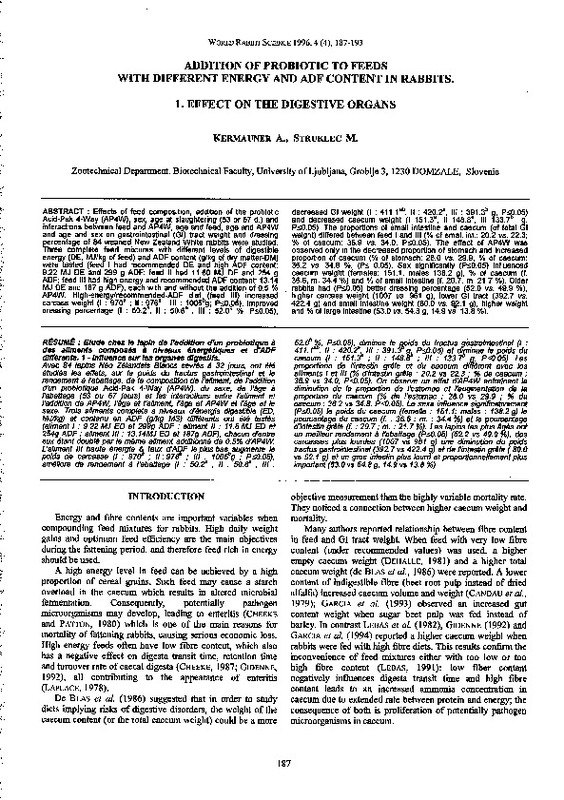|
Resumen:
|
[EN] Effects of feed composition, addition of the probiotic
Acid-Pak 4-Way (AP4W), sex, age at slaughtering (53 or 67 d.) and
interactions between feed and AP4W, age and feed, age and AP4W
and age and sex on gastrointestinal ...[+]
[EN] Effects of feed composition, addition of the probiotic
Acid-Pak 4-Way (AP4W), sex, age at slaughtering (53 or 67 d.) and
interactions between feed and AP4W, age and feed, age and AP4W
and age and sex on gastrointestinal (GI) tract weight and dressing
percentage of 84 weaned New Zealand White rabbits were studied.
Three complete feed mixtures with different levels of digestible
energy (DE, MJ/kg of feed) and ADF content (g/kg of dry matter-DM)
were tested (feed 1 had recommended DE and high ADF content:
9.22 MJ DE and 299 g ADF; feed 11 had 11.60 MJ DE and 254 g
ADF; feed 111 had high energy and recommended ADF content: 13.14
MJ DE and 187 g ADF), each with and without the addition of 0.5 %
AP4W. High-energy/recommended-ADF diet (feed 111) increased
carcass weight (1 : 970ª ; 11: 976ª ; 111 : 1005bg; P:S:OJ>5), improved
dressing percentage (1 : 50.2ª, 11 : 50.6ª , 111 : 52.0 %, P:S:0.05), decreased GI weight (1 : 411.1ab, 11 : 420.2ª, 111 : 391.3b g, P~.05)
and decreased caecum weight (1 151.3ª, 11 148.8ª, 111 133. 7 g,
P:S:0.05). The proportions of small intestine and caecum (of total GI
weight) differed between feed 1 and 111 (% of small int.: 20.2 vs. 22.3;
% of caecum: 36.9 vs. 34.0, P:S:0.05). The effect of AP4W was
observed only in the decreased proportion of stomach and increased
proportion of caecum (% of stomach: 28.0 vs. 29.9, % of caecum:
36.2 vs. 34.8 %, (P:S: 0.05). Sex significantly (P:S:0.05) influenced
caecum weight (females: 151.1, males 138.2 g), % of caecum (f.
36.6, m. 34.4 %) and % of small intestine (f. 20.7, m. 21.7 %). Older
rabbits had (P:S:0.05) better dressing percentage (52.0 vs. 49.9 %),
higher carcass weight (1007 vs. 961 g), lower GI tract (392.7 vs.
422.4 g) and small intestine weight (80.0 vs. 9~.1 g), higher weight
and % of large intestine (63.0 vs. 54.8 g, 14.9 vs. 13.8 %).
[-]
[FR] Avec 84 lapins Néo Zélandais Bienes sevrés a 32 jours, ont été
étudiés les effets, sur le poids du tractus gastrointestinal et le
rendement a l'abattage, de la composition de l'aliment, de l'addition
d'un probiotique ...[+]
[FR] Avec 84 lapins Néo Zélandais Bienes sevrés a 32 jours, ont été
étudiés les effets, sur le poids du tractus gastrointestinal et le
rendement a l'abattage, de la composition de l'aliment, de l'addition
d'un probiotique Acid-Pak 4-Way (AP4W). du sexe, de /'~ge a
l'abattage (53 ou 67 jours) et les interactions entre l'aliment et
l'addition de AP4W. /'~ge et l'aliment, /'~ge et AP4W et /'~ge et le
sexe. Trois aliments complets a niveaux d'énergie digestible (ED,
MJ/kg) et contenu en ADF (glkg MS) différents ont été testés
(aliment I : 9.22 MJ ED et 299g ADF; aliment /1 : 11.6 MJ ED et
254g ADF; aliment 111: 13.14MJ ED et 187g ADF), chacun d'entre
eux étant doublé par le m~me aliment additionné de 0.5% d'AP4W.
L'aliment 111 haute énergie & taux d'ADF leflus bas augmente le
poids de carcasse (I : 97a8 ; 11: 97ft ; /1 : 1005'g ; PS0.05),
améliore de rendement a l'abattage (1 : 50.~ ; /1 : 50.ft ; /11 : 52.d' (j. PS0.05), diminue le R.Oids du tractus r¡astrointestinal (1 :
411.1ª, 11: 420.°2", 111 : 391.3" q¡, PS0.05) et d1cninue le poids du
caecum (1 : 151.J8 ; 11 : 148.ir ; /11 : 133.7" g, PS0.05). Les
proporlions de l'intestin grOle et du caecum différent avec les
aliments I et /11 (% d'intestin grOle : 20.2 vs 22.3 ; % de caecum :
36.9 vs 34.0, Ps0.05). On observe un effet d'AP4W entra1nant la
diminution de la proporlion de l'estomac et l'augmentation de la
proportion du aaecum (% de /'estomac : 28.0 vs 29.9 ; % du
caecum: 36.2 vs 34.8, Ps0.05). Le sexe influence significativement
(Ps0.05) le poids du caecum (feme/le : 151.1; males : 138.2 g) le
pourcentage du caecum (f. : 36.6; m. : 34.4 %) et le pourcentage
d'intestin grOle (f. : 20.7; m. : 21.7 %). Les lapins les plus ~gés ont
un meilleur rendement a l'abattage (Ps0.05) (52.2 vs 49.9 %), des
carcasses plus lourdes (1007 vs 961 g) une diminution du poids
tractus gastrointestinal (392. 7 vs 422.4 g) et de l'intestin grOle ( 80. O
vs 92. 1 g) et un gros intestin plus lourd et proporlionnel/ement plus
important (63.0 vs 54.8 g, 14.9 vs 13.8 %).
[-]
|








